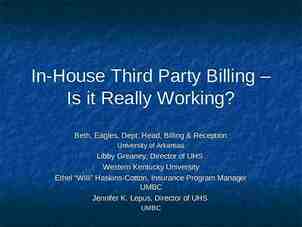Highlights from the 2013 Social Security Trustees Report Chuck Blahous
14 Slides673.00 KB
Highlights from the 2013 Social Security Trustees Report Chuck Blahous Public Trustee Social Security and Medicare
Social Security Tax Income and Expenditures (Hypothetical Combined Trust Funds, as % of Taxable Worker Wages)
Three Factors that Drive the Shortfall 1) Demographics (and failure to adjust to them) 2) Growth in per-capita benefits 3) Pay-as-you-go financing
Demographics: Fewer Workers to Support Each Beneficiary
The Baby Boom Was Followed by a Baby Bust: Beneficiary Rolls Swelling as Ranks of Workers Thin
Eligibility Ages Do Not Reflect Rising Life Expectancy (LE)
Per-Capita Payments Rising Under Current Benefit Formula (Scaled Medium Earner, Initial Annual Retirement Benefit in 2013)
Spectrum of Policy Choices (Maintaining solvency of hypothetical “combined” trust fund) Choices today: 1) Payroll tax rate 12.4% 15.06% 2) Cut benefits 16.5% for current/future beneficiaries 3) Reduce sched. benefits 19.8% for future beneficiaries 4) Combination of above approaches Choices in 2033: 1) Payroll tax rate 12.4% 16.5% ( 1/3 increase) 2) Cut benefits 23% for current/future beneficiaries 3) Required reductions for future beneficiaries 100%
Immediate Problem Is Disability Trust Fund Depletion, but Retirement Trust Fund Has Larger Deficit (Trust funds financed separately by law) Trust Fund Disability (DI) Old-Age and Survivors (OASI) Hypothetical Combined (OASDI) 2013 Cost (as % of Payroll) 2.44 11.51 13.95 Peak Cost (Yr) (as % of Payroll) 2.46 (2012) 15.73 (2087) 18.01 (2087) Costs at Growth Peak (% of Payroll) 2.31 (2009) 12.59 (2022) 14.97 (2023) Depleted in: 2016 2035 2033 75-Yr Imbalance (as % of Payroll) 0.32 2.40 2.72 75-Yr Imbalance (as % of Revenues) 17 20 20 % of Sched. Benefits Payable Upon Depletion 80 75 77
Pressures Shifting from Disability to Retirement Fund (Annual cash balances as a % of taxable payroll)
Even Relative to its Larger Size, the OASI (Retirement) Trust Fund’s Long-term Shortfall Is Larger (Annual cash balances as a % of tax revenues)
Social Security’s Current Shortfall Is Nearly Twice as Large as during 1982-83 Crisis (Projected annual balances, 2013 vs. 1982 reports) 2 % of Worker Wages 1 0 -1 -2 1982 Report -3 2013 Report -4 -5 -6 3 8 13 18 23 28 33 38 43 48 53 58 63 68 73 Years from Date of Report
The Shortfall Consists of an Excess of Scheduled Benefits over Taxes for Those Already in the System (All quantities given as a % of future worker wages) a) Cost of financing benefits for current participants 9.0% b) Surplus tax income paid by current/past participants to date (now in trust fund) 0.4% c) Projected future tax income from current participants 4.4% d) Net income loss for those now entering 4.2% (of wages) the workforce (assuming payment of scheduled benefits) ( a – b – c)
Summary 1) Social Security faces a substantial shortfall driven primarily by demographic factors interacting with program formulas and financing methods. The most immediate threat is the depletion of its disability insurance trust fund, now projected for 2016. 2) This near-term financing shortfall requires prompt legislative action. The disability trust fund’s projected depletion is best addressed without weakening Social Security’s old-age and survivors trust fund. 3) Delay has allowed the shortfall to grow to where it now cannot be corrected without measures substantially more severe than those enacted in 1983. Continued delay further reduces the chances that a bipartisan solution can be found that maintains Social Security’s historical financing structure.



















